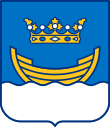Prior to 19th century
| Part of a series on |
| Scandinavia |
|---|
 |
- 1550 - Trading town established by Gustav I of Sweden. [1]
- 1569 - City privileges granted. [2]
- 1570 - Fire. [2]
- 1616 - "Diet of Finland held in Helsinki." [2]
- 1640 - Helsinki relocated across Kluuvinlahti bay to Vironniemi" [2]
- 1654 - Fire. [2]
- 1695 - Famine begins. [2]
- 1710 - Plague. [2]
- 1713 - Helsinki taken by Russian forces. [3]
- 1727 - Ulrika Eleonora Church built.
- 1742 - Helsinki occupied by Russians again. [3]
- 1743 - Herring fair begins.[ citation needed ]
- 1748 - Sveaborg fortress construction begins. [3]
- 1757 - Sederholm house built. [2]



